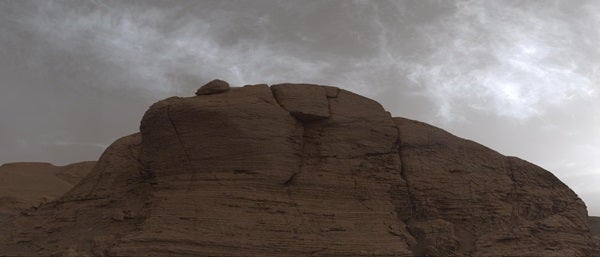Cloud watching isn’t only for earthlings. NASA’s Curiosity rover, currently trundling through the foothills of Mars’ Mount Sharp, recently snapped several photos of stunning clouds in the martian sky.
Clouds on Mars are relatively rare, thanks to the planet’s thin, dry atmosphere. But they do appear near the equator when Mars is near aphelion, its farthest point from the Sun, which is when Mars experiences the coldest part of its year. The Red Planet is approaching that point now and will officially reach it late on the evening of July 12.
The last time Mars reached aphelion (about two Earth years ago), Curiosity’s team noticed something odd: Clouds were arriving on the scene earlier than expected. So this year, the team set about scanning the skies earlier than they might have otherwise planned, hoping to again spot the phenomenon.
Curiosity saw its first early clouds of the season in January. Further study indicated they were different than the usual clouds on Mars. Most martian clouds are made of water ice that hovers low to the ground (within 37 miles [60 kilometers]). But these unseasonably early clouds appear to be composed of carbon dioxide ice — familiar to most readers as dry ice — and occur much higher in the atmosphere. This means they reflect sunlight before sunrise and after sunset, when the Sun is below the local horizon, yet its rays can still bounce off the high-flying clouds.
These are called noctilucent (night-glowing) clouds, and they’re frequently seen on Earth during the spring and summertime. The only difference is that on Earth, noctilucent clouds are formed when water ice crystalizes around high-altitude dust particles. But Mars’ noctilucent clouds are made of carbon dioxide ice.
Curiosity also spotted nacreous clouds, which are often called mother-of-pearl clouds for their shimmering, iridescent color. These are likewise high-altitude clouds illuminated by the Sun when it is below the horizon. Nacreous clouds are slightly different than noctilucent clouds — the former occur only when the ice particles are all of similar sizes, and also form lower in the atmosphere than noctilucent clouds, which occur even higher up.
Researchers hope that further studying these glowing clouds will reveal even more about the martian atmosphere, as well as why — and when — clouds form within it.











